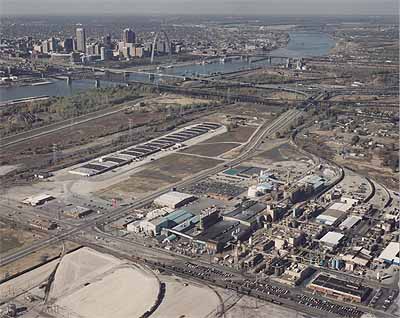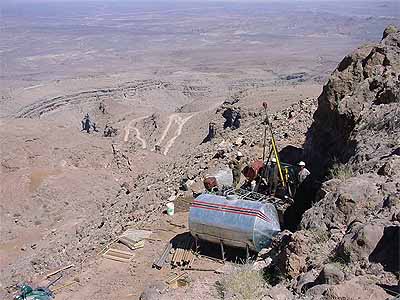ZincOx Resources
ZincOx is making the grade
In 1997, ZincOx Resources plc was formed, with the objective of identifying and developing nonsulphide zinc deposits around the world.
Whilst in the process of engineering technology for the task, and with a heavy focus upon R&D, the company further began to examine secondary and waste materials from which zinc might be recovered. Of particular interest to ZincOx was the waste generated from recycling galvanised steel, electric arc furnace dust (EAFD), owing to its highgrade zinc and plentiful supply. As a consequence of its investment in these two broad areas of mining and recycling, the company, which now has offices in Europe and the US, has placed itself at the forefront of technology designed to extract zinc from unconventional materials.
Andrew Woollett, co-founder and executive chairman of ZincOx, explains the key factors behind the company’s burgeoning reputation: “We have put together an exceptional team of engineers and metallurgists, who between them represent one of the world’s finest research resources for zinc. In addition, we have a management team that has experience of putting projects together. This is an essential point, because the technology that we have developed would count for little if we did not have the wherewithal to translate it into real success. Combining this with the increasing portfolio of waste we now have under agreement or under discussion with steel mills, and I think we are ticking all of the important boxes. We are technology driven, and have a niche market which we are making our own.”
The company’s zinc metal products would be usable within numerous applications, amongst which galvanising is the most common. It is further exploited as a die-casting alloy, and can be combined with copper to produce different types of brasses. Alkaline batteries, too, are manufactured from atomised granular zinc. ZincOx produces four grades of zinc metal at its Big River Zinc refinery in Missiouri, which are commonly used in industry: Special High Grade, High Grade, Continuous Galvanising Grade, and Prime Western Grade. Each differs in its composition of lead, aluminium, cadmium and iron, though ZincOx is able to produce other compositions based upon individual customer specifications.
The company has devoted much of its work, in the past year, to the successful establishment of the Ohio Recycling Project (ORP). In November 2007, a seven-hectare plant site was acquired in the northwest of the US state, and, in February of this year, the last of the relevant permits was granted. The “Air Permit”, which is the sixth to be granted, demonstrated the support that the project enjoys both from the state and local community, and reflects the positive impact that the process should have on the environment. Indeed the company is winning notable praise for the emphasis that it is placing on this: in November 2007 ZincOx was named the winner of Mining Journal’s Outstanding Achievement Award for Sustainable Development, for its work with EAFD, which is a bio-hazardous waste.
The ORP will comprise a rotary hearth furnace, and a submerged arc electric melter, and it is planned that the plant will treat 200,000 tonnes of EAFD per year. The rotary hearth furnace will produce a concentrate containing zinc and lead, and direct reduced iron, which will be transferred to the melter to separate the pig iron and byproduct slag. The zinc concentrate will be transported to BRZ for further processing, whilst the pig iron will be sold back to the steel mills from which the EAFD originated. The slag, meanwhile, will be sold to the construction industry. On this basis, the EBITDA of the ORP, at full production, will be $57.7 million per annum.
Andrew highlights one of the major financial benefits of the process that ZincOx employs as part of its work: “There are other people recycling EAFD who do so without producing pig iron. They are therefore entirely dependent upon revenue from
zinc, the price of which has dropped over the last two years. Furthermore, many other people use coke to effect the transformation, which is highly expensive at the moment. We are in a strong position for two reasons: firstly, we use coal, not coke; secondly the pig iron that we are able to produce from the EAFD is extremely valuable at the moment. Indeed, we are somewhat insulated from the fall in the price of zinc by the very buoyant cost of pig iron at present.”
ZincOx has yet further expertise in the development of zinc oxide products. In this process, too, the company sets itself apart from traditional approaches, an Andrew explains: “We have modified a technology that is used in the nickel business. We are able to dissolve the zinc out of rock after it has been crushed, and then precipitate out zinc carbonate, which can be easily transformed into zinc oxide. This is produced directly as industrial or chemical grade zinc oxide, and can be sold directly to industrial users. In the vast majority of cases around the world, this end material is actually produced from shiny new metal or high quality scrap. In such instances it must trade at a premium, in order to add a margin to the transformation and marketing of the product. We do not have that problem, as we start with rock which comes for free, so we are at a considerable cost advantage compared to other zinc oxide manufacturers.”
The production of zinc oxide is a key element to the company’s work at the Jabali Zinc Mine in Yemen. The exploitation and development rights of the deposit are owned by Jabal Salab Company, in which ZincOx possesses a 52 per cent interest. The site itself contains a mineable reserve of 8.7 million tonnes of ore, and will be mined at a rate of 800,000 tonnes per annum. By utilising the aforementioned development process, this will allow for the production of 70,000 tonnes of high quality zinc oxide on a yearly basis. This will then be bagged, and shipped to customers in the rubber, paint, and ceramics industries. It is estimated that the construction of the mine and other relevant facilities will be complete near the end of 2009, and Caterpillar mining equipment has already been delivered to Yemen. In addition, an access road and site camp sufficient for 300 people are under construction.
The Jabali project enjoys ardent support from the Government of Yemen. It is, in fact, the first large scaling mining programme to be undertaken in the country, and is being viewed, in the political sphere, as a way of moving away from the country’s existing dependence on the oil sector. Local communities are also enthusiastic regarding the prospective benefits of the work, including employment possibilities, and improved infrastructure in relation to roads and water. These are improvements that should continue to have an impact long beyond the life of the mine itself.
Whilst its future projects clearly hold much promise, ZincOx currently enjoys a significant revenue stream from the sale of a deposit that it made some years ago. In 2003, the company completed a deal with zinc producer Kazzinc – owned by Glencore – relinquishing ZincOx’s interest in the Shaimerden Zinc Deposit in Kazakhstan. The company continues to receive an income from this, however, through an agreement that stipulated deferred payments linked to zinc price. In January of this year, for example, the company received $31.4 million relating to 2007, and is expecting further such payments through until 2011.
This contributed to a threefold increase in profits to £11.4 million last year, as a consequence of which the future of the business looks highly promising. Furthermore, Andrew explains that, alongside its existing work, ZincOx will be kept busy by the continuing expansion of its portfolio: “I see us completing the development of our first recycling project in about 18 months. Over the same period, we will be putting in place two or three new projects that we can work on, so that – in a few years – we may have production from as many as four recycling plants. This would provide us with around 200,000 tonnes of zinc per year, and continue to help us towards becoming one of the biggest producers in the world.”
As part of its ambitious growth objectives, ZincOx will also be developing a site in Turkey, and has, in the past year, revealed plans to begin recycling EAFD in the Far East. In Thailand, the company is hoping to construct a plant, similar in size and design to that which is being developed in Ohio. This will operate as a regional facility, processing EAFD both from Thailand and other nearby countries. ZincOx has already acquired an option on five hectares of land on a site within the heavily industrialised area of Chonburi. Furthermore, supply option agreements have been secured with seven steel mills, and further such contracts are expected before the end of 2008. This, amongst a number of other prospective developments, leavesAndrew feeling highly optimistic about the future of the business. Concluding with his long-term vision for ZincOx, he simply states: “We want to become the biggest zinc recycling company in the world.” The company’s rapid progression over the past decade suggests that this is by no means an unrealistic target.
ZincOx Resources
Products: Zinc metal and zinc oxide
Sites: Worldwide
www.zincox.com
